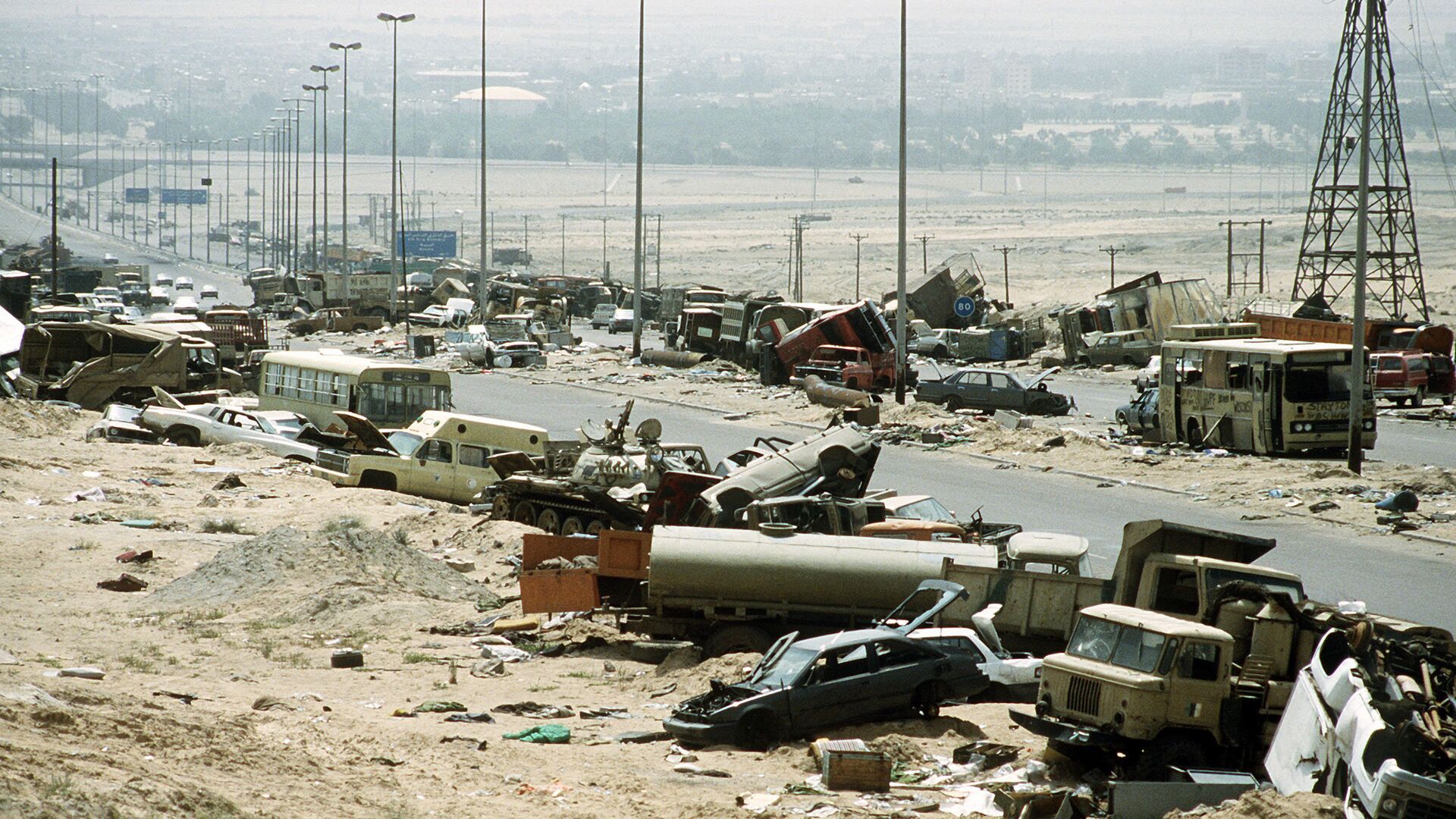https://sputnikglobe.com/20231219/us-vet-on-depleted-uranium-i-saw-disfigured-newborns-and-my-dad-dying-from-cancer-1114153992.html
Ex-US Airman on Depleted Uranium: 'I Saw Disfigured Newborns & My Dad Dying From Cancer'
Ex-US Airman on Depleted Uranium: 'I Saw Disfigured Newborns & My Dad Dying From Cancer'
Sputnik International
Damacio A. Lopez, a US Air Force veteran who has firsthand knowledge of depleted uranium arms' deadly effect on human chromosomes and the environment, told Sputnik why the supply of DU rounds spells long-lasting disaster for Ukraine.
2023-12-19T05:00+0000
2023-12-19T05:00+0000
2023-12-23T18:57+0000
depleted uranium
iraq
socorro
us department of defense (dod)
us air force
pentagon
ukraine
iraq war
gulf war
kosovo
https://cdn1.img.sputnikglobe.com/img/106074/81/1060748180_0:0:2837:1597_1920x0_80_0_0_ff337a80e4732600b64f586a4e89dbb4.jpg
Following the costly failure of their “summer counteroffensive,” the Ukrainian military has begun desperately searching for “wonder weapons” to restore their battlefield fortunes.Announcing the provision of DU rounds to Ukraine, Washington insisted in September that there's nothing to worry about: the wonder-weapon is somewhat toxic, but overall harmless and fine. Rafael Grossi, International Atomic Energy Agency (IAEA) director general, joined the chorus, asserting to the public that there are "no significant radiological consequences" from the use of depleted uranium shells.These are barefaced lies, according to Damacio A. Lopez, a US Air Force veteran and a member of Veterans For Peace and co-chair of its Depleted Uranium Working Group. He founded the International Depleted Uranium Study Team and co-founded the International Coalition to Ban Uranium Weapons (ICBUW).Damacio was one of the first Americans who raised the red flag about the disastrous consequences of the weapons. Since 1985, he has been seeking a global ban on depleted uranium arms, which are still not covered by international chemical or nuclear conventions, despite DU's toxicity and radioactivity.Sinister Black Cloud Over SocorroDamacio was born in Socorro, a southern town in central New Mexico along the Rio Grande. Back in 1945, the Trinity nuclear test rocked the Jornada del Muerto Desert, only 36 miles southeast of his hometown. Damacio was only two years at that time, but later he became curious about radiation hazards.The Trinity blast wasn't the only US nuclear experiment in the region. In 1985, when Lopez visited his parents in Socorro during the Christmas holidays, the first thing he heard on his arrival was the sound of very loud explosions less than two miles from his house. Explosions occurred regularly, making dishes rattle and causing cracks in the walls. But even more alarming was a dark black cloud hovering over the town after the blasts.Lopez went to a Board of Regents meeting and asked about the explosions and dark clouds of smoke. But in response, he only got evasive answers.Still, his efforts bore some fruit: one morning, he found five mysterious boxes in the front yard of his Socorro house. When he opened them, he found documents shedding light on the ongoing disaster.He learned that the black cloud that he saw was radioactive and chemically toxic dust ejected into the atmosphere by depleted uranium blasts.Damacio decided to dig deeper. He knew that the exposure to nuclear materials could lead to health problems, so he went to the Health Department in Santa Fe and sought information about Socorro's residents. The records gave him the shivers: over past years, the community's health problems had piled up, with the number of cases of hydrocephalus, cancer, and birth defects higher than in the other counties around the state.This gruesome discovery prompted him to start researching the effects of depleted uranium contamination.Horrific Effects of Exposure to Depleted UraniumIn the late 1990s, Damacio was invited to Iraq by the nation's authorities to speak at a conference on the depleted uranium weapons used in the country by the US during the Persian Gulf War (1990-1991). In 1993, Lopez and his fellows published the book Uranium Battlefields Home and Abroad: Depleted Uranium Use by the US Department of Defense, looking into DU testing sites in the US and the Pentagon's use of the weapons abroad. The US and its allies unleashed over 300 tons of DU in Iraq."I found a lot of [health] related issues. At that conference that I went to, I learned a lot of things and I was one of the speakers at this conference. And so I was able to get studies from these medical people who had done a lot of studies on the people in Iraq and birth defects, cancers. These were the top things that were going on in their country, and some of the cancers were the same cancers, the same cancer that my father died from. And a lot of other people in the town were having problems in Socorro with birth defects. So I was able to go into hospitals in Iraq to see for myself the people who were victims."But the greatest shock for Damacio was Iraqi children who were born after the US bombing campaign. When he recalls them, he cannot hold back his tears."In one particular hospital I was able to see many, many children with birth defects that were so severe that it was so hard for me to think of them as even human."The little boy looked listless. Damacio thought for a moment that the toddler couldn't see or hear. "And as I was leaving the room, I heard the little boy scream out: 'Mama, mama!' And it sent chills through my entire body."If Damacio were told at the time that the US government would throw another thousand tons of depleted uranium on Iraq in just three weeks during the Second Gulf War, it would have stopped the researcher's heart.Geiger Counter Never Lies: DU Weapons are RadioactiveLopez suspected that these hideous birth defects and the spike in cancer cases were caused by depleted uranium's radioactivity and toxicity. Preparing for his Iraq trip, he took his Geiger counter. The radiation detector "could identify alpha, beta, and gamma, and could identify whether it was depleted uranium or something more hot than depleted uranium," according to the researcher.While in Baghdad, Damacio visited the Amiriyah shelter, which was subjected to a US aerial attack that killed over 400 civilians, including children, on February 13, 1991."Eyewitnesses told me, more than one said to me: 'Damacio, what happened here is… I saw this projectile. I saw this large Tomahawk cruise missile making curves around streets.' And then, when they got to the Amiriyah shelter, they went up high, came straight down in the middle of the shelter that had three stories, three feet of concrete between the stories to protect the people in there. In this case, children. There were more than 600 kids and school kids in that shelter at this time. The missile came down from the middle of the shelter, went through, went all the way down to the bottom of the shelter, and then went into a deep hole there. I saw all this, and they're watching it."Lopez decided to find remnants of projectiles used during the US bombing of Baghdad and other areas and make measurements. He knew that typically, natural background radiation levels could range between five and 60 counts per minute, or a little more. Anything higher than that meant potential radioactive contamination."I found in one of the facilities in Baghdad after going to the Amiriyah shelter, there was an exhibition, there was a big building and they had picked up all the war remnants that they had found. One of them was partially, about three quarters, a Tomahawk cruise missile. And I had my detector and I checked it out. It was about a hundred counts per minute, which was an indication that there was radiation within this Tomahawk cruise missile."Then he travelled to a site on the border between Kuwait and Iraq, dubbed the "Highway of Death," where thousands of Iraqi tanks and armored vehicles were pierced and burned by DU munitions fired by US A-10 Warthogs. There, he got readings of about 100-120 counts per minute on the holes of the damaged tanks. Lopez also collected small pieces of metal as samples that showed a reading of 600 counts per minute.DU Weapons are Made of Radioactive WasteLopez tried to find out why the US had decided to use depleted uranium for its ammo in the first place.Damacio's book Uranium Battlefields Home and Abroad: Depleted Uranium Use by the US Department of Defense explains that DU is a byproduct of the uranium enrichment process by which the fissionable isotope uranium-235 (U235) is extracted from natural uranium for subsequent use as fuel for nuclear reactors.Natural uranium, a silvery-grey metal, contains 0.7% U235, 99.3% U238, and a small amount of U234 by mass. After producing 85 kilograms of enriched uranium, one would get 915 kg of U238, or depleted uranium.The Pentagon argues that U238 retains "only" 60% of natural uranium's radioactivity and emits alpha particles, which have low penetration depth and can be stopped by skin. Inside the body, however, alpha-emitters can be extremely harmful, damaging sensitive living tissue. After the explosion of DU projectiles, microscopic and light uranium dust can travel with the wind, be inhaled, swallowed, or enter the body through a wound, later causing cancer and chromosome damage.Why Do Pentagon and Defense Contractors Like DU So Much?Lopez explained that from a military standpoint, the most important property of DU is its great density, relatively low cost of fabrication, and availability. The material is used for tank armor and projectiles of different sizes.Highly-dense DU munitions easily pierce tanks and other armored vehicles. While tungsten carbide projectiles are capable of doing the same, DU is cheaper, more accessible, and offers greater margins for US military firms.On the other hand, turning spent uranium into bullets and shells has become an "ingenious" solution for the US nuclear industry on how to "dispose" of radioactive waste, Lopez said in his book. So, as money talks, the US' testing and use of DU weapons continue unabated, according to the activist.But has the Pentagon ever been aware of the long-lasting hazard related to DU projectiles?The US Department of Defense's internal memos, leaked to the press in the late 1990s and the beginning of the 2000s, indicate that the Pentagon knew. But why would it use the toxic and radioactive substance nevertheless?A March 1, 1991 document shows the US DoD's attitude to DU weapons use in a nutshell. Authored by US Lieutenant Colonel M.V. Ziehmn at the Los Alamos Laboratories in New Mexico, the memo reads: "There has been and continues to be a concern regarding the impact of DU [sic] on the environment. Therefore, if no one makes a case for the effectiveness of DU on the battlefield, DU rounds may become politically unacceptable and thus, be deleted from the arsenal."The memo went on by saying: "If DU penetrators proved their worth during our recent combat activities, then we should assure their future existence (until something better is developed)," adding "we should keep this sensitive issue at mind when after action reports [sic] are written"; otherwise the US may lose "a valuable combat capability."Why Are Pentagon and White House Keeping DU's Deadly Effects Secret?The documentary Uranium 238: The Pentagon´s Dirty Pool (2009), used by Lopez's International Coalition to Ban Uranium Weapons (ICBUW) as part of its international campaign to prohibit DU, said that the Pentagon is in denial about DU munitions potentially leading to carcinogenic diseases, birth defects, and environmental contamination.One could easily imagine that if the US government admits DU's hazardous effects, the weapon would be banned, influential defense contractors would be stripped of their profits, and Washington would be slapped with a heap of legal cases with compensation demands.And the US is not the only country that uses depleted uranium as a weapon, as some of its NATO allies also do, according to Lopez.
https://sputnikglobe.com/20230915/bosnia-still-suffering-from-impact-of-depleted-uranium-munition-bombings---ambassador-1113394647.html
https://sputnikglobe.com/20230904/us-depleted-uranium-shells-will-poison-ukraine-wont-change-conflicts-outcome-1113113379.html
https://sputnikglobe.com/20230907/how-us-media-learned-to-love-depleted-uranium-shells-amid-ukraine-counteroffensive-1113179148.html
https://sputnikglobe.com/20231110/fallout-from-catastrophic-ukraine-depleted-uranium-explosion-reached-england-1114872089.html
https://sputnikglobe.com/20231211/how-west-is-turning-ukraine-into-a-waste-disposal-site-1115522175.html
iraq
socorro
ukraine
kosovo
serbia
Sputnik International
feedback@sputniknews.com
+74956456601
MIA „Rossiya Segodnya“
2023
News
en_EN
Sputnik International
feedback@sputniknews.com
+74956456601
MIA „Rossiya Segodnya“
Damacio A. Lopez 1
Sputnik International
Damacio A. Lopez 1
2023-12-19T05:00+0000
true
PT1M26S
Damacio A. Lopez 2
Sputnik International
Damacio A. Lopez 2
2023-12-19T05:00+0000
true
PT2M28S
Damacio A. Lopez 5
Sputnik International
Damacio A. Lopez 5
2023-12-19T05:00+0000
true
PT2M17S
Damacio A. Lopez 6
Sputnik International
Damacio A. Lopez 6
2023-12-19T05:00+0000
true
PT1M42S
Sputnik International
feedback@sputniknews.com
+74956456601
MIA „Rossiya Segodnya“
depleted uranium, us munitions made of depleted uranium, depleted uranium ammo hazardous effects, depleted uranium radioactive and toxic, birth defects caused by depleted uranium, depleted uranium studies, depleted uranium used in gulf war, us and uk sent munitions with depleted uranium to ukraine, is depleted uranium radioactive, is depleted uranium toxic
depleted uranium, us munitions made of depleted uranium, depleted uranium ammo hazardous effects, depleted uranium radioactive and toxic, birth defects caused by depleted uranium, depleted uranium studies, depleted uranium used in gulf war, us and uk sent munitions with depleted uranium to ukraine, is depleted uranium radioactive, is depleted uranium toxic
Following the costly failure of their “summer counteroffensive,” the Ukrainian military has begun desperately searching for “wonder weapons” to restore their battlefield fortunes.
Announcing the provision of
DU rounds to Ukraine, Washington insisted in September that there's nothing to worry about: the wonder-weapon is somewhat toxic, but
overall harmless and fine. Rafael Grossi, International Atomic Energy Agency (IAEA) director general, joined the chorus, asserting to the public that there are "no significant radiological consequences" from the use of depleted uranium shells.
These are barefaced lies, according to
Damacio A. Lopez, a US Air Force veteran and a member of
Veterans For Peace and co-chair of its Depleted Uranium Working Group. He founded the International Depleted Uranium Study Team and co-founded the International Coalition to Ban Uranium Weapons (ICBUW).
"He [Grossi] is part of the team, part of the team that promotes this project, use of these weapons, he is part and parcel of the superpowers that use it and making excuses for it and trying to convince the public that this is not a problem, as they do repeatedly here in this country. You asked what the people thought about this. Well, they haven't been getting accurate information. And I tried my best to get that information out in Uranium Battlefields and go in and talk to all these countries and try to explain what was going on."
Damacio was one of the first Americans who raised the red flag about the disastrous consequences of the weapons. Since 1985, he has been seeking a global ban on depleted uranium arms, which are still not covered by international chemical or nuclear conventions, despite DU's toxicity and radioactivity.
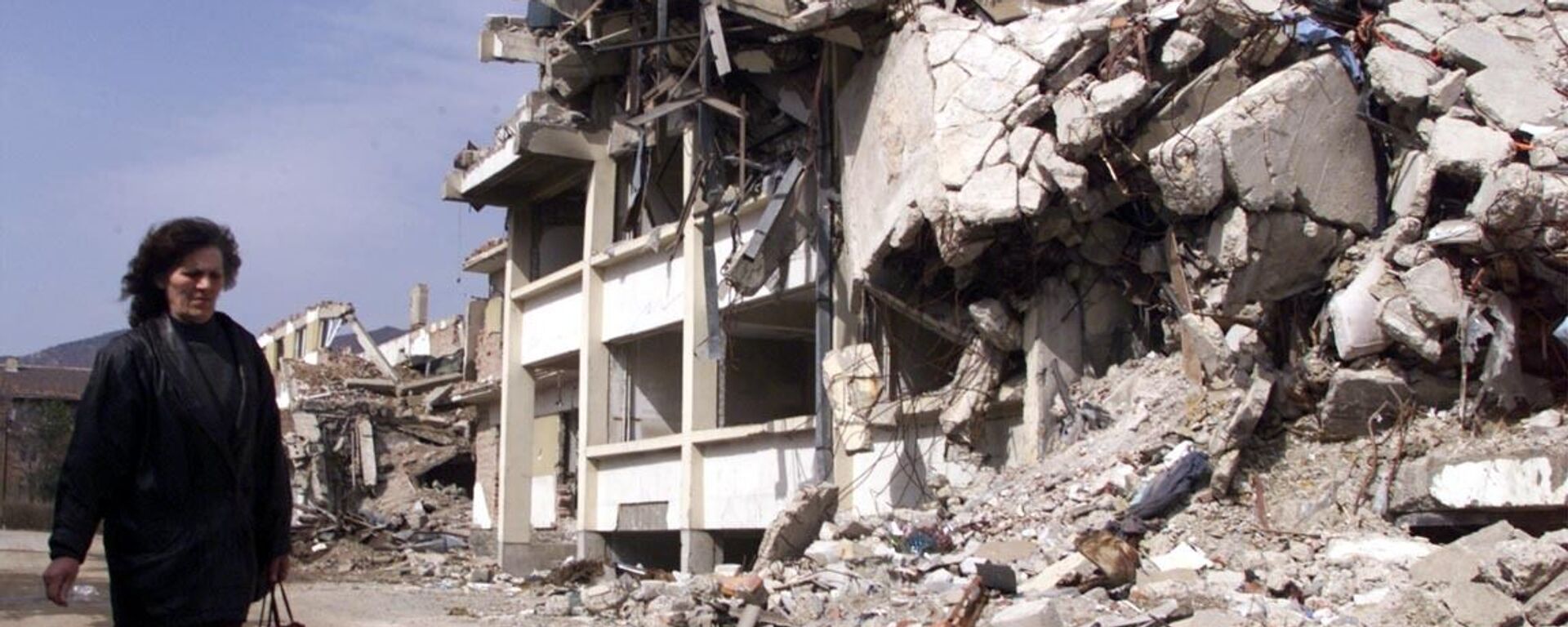
15 September 2023, 13:03 GMT
Sinister Black Cloud Over Socorro
Damacio was born in Socorro, a southern town in central New Mexico along the Rio Grande. Back in 1945, the Trinity nuclear test rocked the Jornada del Muerto Desert, only 36 miles southeast of his hometown. Damacio was only two years at that time, but later he became curious about radiation hazards.
The Trinity blast wasn't the only US nuclear experiment in the region. In 1985, when Lopez visited his parents in Socorro during the Christmas holidays, the first thing he heard on his arrival was the sound of very loud explosions less than two miles from his house. Explosions occurred regularly, making dishes rattle and causing cracks in the walls. But even more alarming was a dark black cloud hovering over the town after the blasts.
"This was disturbing. And it wasn't just my family. It was all the families in Socorro. From the middle of Socorro, the city park, to where the explosions had taken place, is two miles. That's up. And the prevailing winds come over the community every time one of these bombs goes off. And of course, people were very concerned about what was going on. And my Mom asked me to look into this. And so I did. I contacted the Board of Regents of the New Mexico Institute of Mining and Technology, who are responsible for these explosions. Because they had been testing different kinds of weapons there since 1946."
Lopez went to a Board of Regents meeting and asked about the explosions and dark clouds of smoke. But in response, he only got evasive answers.
Still, his efforts bore some fruit: one morning, he found five mysterious boxes in the front yard of his Socorro house. When he opened them, he found documents shedding light on the ongoing disaster.
"Well, those boxes were full of information about depleted uranium and testing in Socorro, and their ideas and what they were doing. And it went way, way back, before 1972, explaining the development of these weapons and what they were trying to do and the different kinds of weapons they were experimenting with, like cluster bombs instead of using metal or tungsten or titanium. They would try depleted uranium and see how that worked. So they were doing these kinds of preliminary testing, along with two other laboratories in New Mexico, plus laboratories outside of New Mexico. They were all working together. And I saw all this information. It wasn't just about Socorro. It was about worldwide testing with what was going on in Europe and who was testing these weapons and what kind of weapons they were testing."
He learned that the black cloud that he saw was radioactive and chemically toxic dust ejected into the atmosphere by depleted uranium blasts.
Damacio decided to dig deeper. He knew that the exposure to nuclear materials could lead to health problems, so he went to the Health Department in Santa Fe and sought information about Socorro's residents. The records gave him the shivers: over past years, the community's health problems had piled up, with the number of cases of hydrocephalus, cancer, and birth defects higher than in the other counties around the state.
This gruesome discovery prompted him to start researching the effects of depleted uranium contamination.
Horrific Effects of Exposure to Depleted Uranium
"I have a brother who's bent over, and when he speaks, and he's 10 years younger than me, something's wrong with his spine," Damacio said. "And his body is kind of flopped over. And when he looks at you, he looks like a turtle. He's way down like this, and looks up. I mean, he's normally about 5 ft 6 in. And now he looks like he's about 4 ft. It's a horrible sight. His teeth are all rotten. He's the one who lives right next to the facility. You know, here's the facility right here. Here's my house. And here is a town. There's a fence between us and it says ‘Keep out, government property.’ And so our family is very close, one of the closest homes to this facility."
"My dad ended up dying from cancer," the activist continued. "And it was a sad situation for us. And like I said earlier, the people there, when they realized the truth about what was going on, instead of saying, ‘Oh, we want to stop this,’ no, they're saying, ‘What? What can we do to survive? How can we survive this thing?’ And well, they couldn't leave. So they just stay. And over the years, refusing sometimes to even acknowledge the dangers around them, because I believe they have no other choice. And it's dehumanizing for people to be in that situation."
In the late 1990s, Damacio was invited to Iraq by the nation's authorities to speak at a conference on the depleted uranium weapons used in the country by the US during the Persian Gulf War (1990-1991). In 1993, Lopez and his fellows published the book Uranium Battlefields Home and Abroad: Depleted Uranium Use by the US Department of Defense, looking into DU testing sites in the US and the Pentagon's use of the weapons abroad. The US and its allies unleashed over 300 tons of DU in Iraq.
"Well, when I went to Iraq and I told the people, I want to see if what's happening here is happening there as well. So I'm not only the victim, but I'm also a researcher and I want to have accurate information. I just don't want to take other people's word for things. And I don't, and I never have. Maybe at the very beginning of my discovery I did that. But since then, I want to see the people involved in these situations."
"I found a lot of [health] related issues. At that conference that I went to, I learned a lot of things and I was one of the speakers at this conference. And so I was able to get studies from these medical people who had done a lot of studies on the people in Iraq and birth defects, cancers. These were the top things that were going on in their country, and some of the cancers were the same cancers, the same cancer that my father died from. And a lot of other people in the town were having problems in Socorro with birth defects. So I was able to go into hospitals in Iraq to see for myself the people who were victims."
But the greatest shock for Damacio was Iraqi children who were born after the US bombing campaign. When he recalls them, he cannot hold back his tears.
"In one particular hospital I was able to see many, many children with birth defects that were so severe that it was so hard for me to think of them as even human."
"I'm talking about very, very serious birth defects. Can you imagine walking into a place and seeing a child with one eye and his forehead? It's like not even human. And I met this little boy. He was three years old. He was with his mother and he had a big head, hydrocephalus. And one eye was turned up and his other eye was turned down. He was skin and bones. He was three years old, couldn't weigh more than 20 pounds. And his head was huge. Little tiny, tiny legs. It's almost skin and bone. And the mother was holding him and wiping the blood from his mouth. And as I was leaving the hospital, tears started streaming down my face. I couldn't control it. It was so, so bad."
The little boy looked listless. Damacio thought for a moment that the toddler couldn't see or hear. "And as I was leaving the room, I heard the little boy scream out: 'Mama, mama!' And it sent chills through my entire body."
If Damacio were told at the time that the US government would throw another thousand tons of depleted uranium on Iraq in just three weeks during the Second Gulf War, it would have stopped the researcher's heart.
Geiger Counter Never Lies: DU Weapons are Radioactive
Lopez suspected that these hideous birth defects and the spike in cancer cases were caused by depleted uranium's radioactivity and toxicity. Preparing for his Iraq trip, he took his Geiger counter. The radiation detector "could identify alpha, beta, and gamma, and could identify whether it was depleted uranium or something more hot than depleted uranium," according to the researcher.
While in Baghdad, Damacio visited the Amiriyah shelter, which was subjected to a US aerial attack that killed over 400 civilians, including children, on February 13, 1991.
"It was quite a sight when I was looking at the blood and hairs of the people on the walls and the children. And then there was an area where they had all their pictures. I was there with the Japanese delegation in this particular visit. And for them, it was common – it was not common, but they knew this well about the shadows on the wall and the hair and the blood from what happened in their country when they were bombed. So they understood all this."
"Eyewitnesses told me, more than one said to me: 'Damacio, what happened here is… I saw this projectile. I saw this large Tomahawk cruise missile making curves around streets.' And then, when they got to the Amiriyah shelter, they went up high, came straight down in the middle of the shelter that had three stories, three feet of concrete between the stories to protect the people in there. In this case, children. There were more than 600 kids and school kids in that shelter at this time. The missile came down from the middle of the shelter, went through, went all the way down to the bottom of the shelter, and then went into a deep hole there. I saw all this, and they're watching it."
Lopez decided to find remnants of projectiles used during the US bombing of Baghdad and other areas and make measurements. He knew that typically, natural background radiation levels could range between five and 60 counts per minute, or a little more. Anything higher than that meant potential radioactive contamination.
"I found in one of the facilities in Baghdad after going to the Amiriyah shelter, there was an exhibition, there was a big building and they had picked up all the war remnants that they had found. One of them was partially, about three quarters, a Tomahawk cruise missile. And I had my detector and I checked it out. It was about a hundred counts per minute, which was an indication that there was radiation within this Tomahawk cruise missile."
Then he travelled to a site on the border between Kuwait and Iraq, dubbed the "Highway of Death," where thousands of Iraqi tanks and armored vehicles were pierced and burned by DU munitions fired by US A-10 Warthogs. There, he got readings of about 100-120 counts per minute on the holes of the damaged tanks. Lopez also collected small pieces of metal as samples that showed a reading of 600 counts per minute.
"And I happened to find several projectiles, 30 millimeters, that had missed the target and hit the ground and bounced. And they were intact. So I checked them out with my detector, thinking I'm going to get 600 counts per minute. I was getting 2,500 per minute on these projectiles, so high that my radiation detector wouldn't go any higher than in its capabilities. And it would go ‘u-u-u-u,’ could have been higher than 2,400 counts per minute. And the only conclusion I could draw from that is that nuclear waste from nuclear facilities was being mixed with what was so-called depleted uranium. And this became even more alarming."
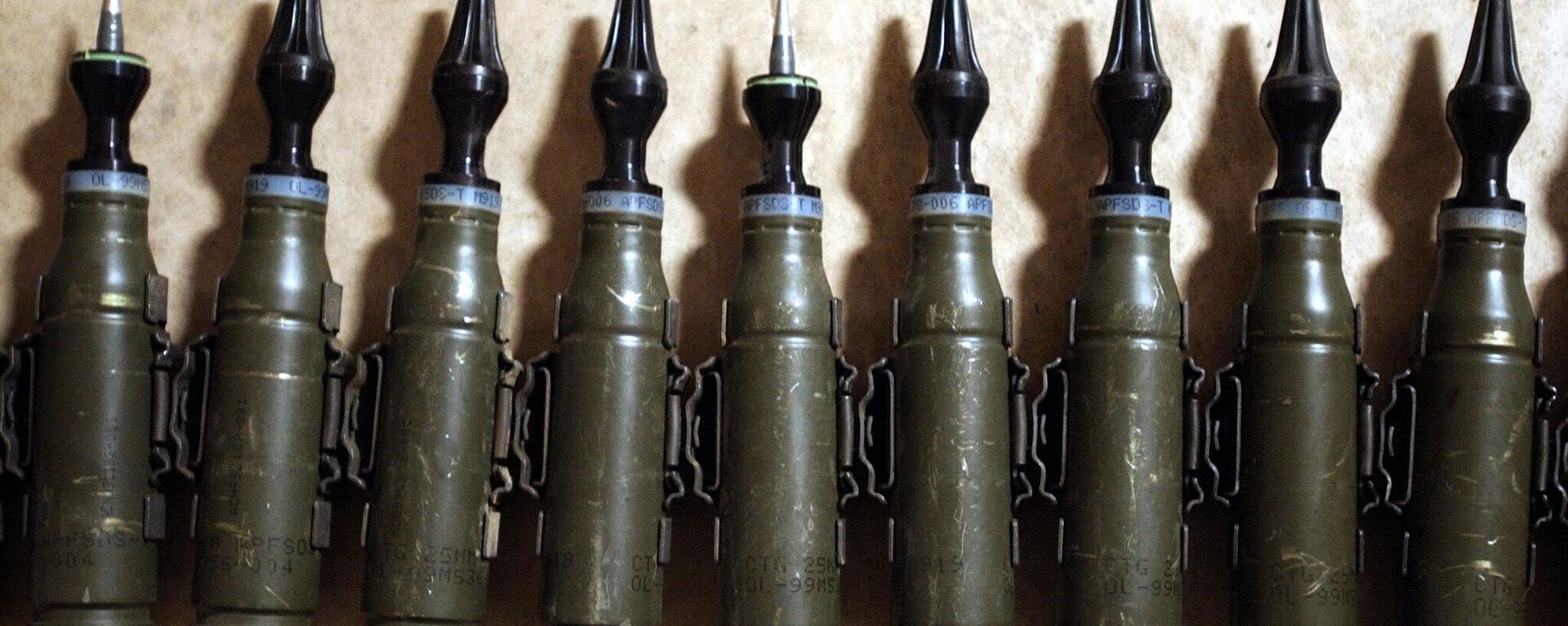
4 September 2023, 15:47 GMT
DU Weapons are Made of Radioactive Waste
Lopez tried to find out why the US had decided to use depleted uranium for its ammo in the first place.
Damacio's book Uranium Battlefields Home and Abroad: Depleted Uranium Use by the US Department of Defense explains that DU is a byproduct of the uranium enrichment process by which the fissionable isotope uranium-235 (U235) is extracted from natural uranium for subsequent use as fuel for nuclear reactors.
Natural uranium, a silvery-grey metal, contains 0.7% U235, 99.3% U238, and a small amount of U234 by mass. After producing 85 kilograms of enriched uranium, one would get 915 kg of U238, or depleted uranium.
The Pentagon argues that U238 retains "only" 60% of natural uranium's radioactivity and emits alpha particles, which have low penetration depth and can be stopped by skin. Inside the body, however, alpha-emitters can be extremely harmful, damaging sensitive living tissue. After the explosion of DU projectiles, microscopic and light uranium dust can travel with the wind, be inhaled, swallowed, or enter the body through a wound, later causing cancer and chromosome damage.
One should bear in mind that depleted uranium is radioactive waste that should be disposed of, Lopez pointed out in his book. However, almost all DU tails have been saved by the US government since the early 1940s. Moreover, they can be purchased for commercial use, according to the researcher. To date, the US has accumulated a massive storage of DU amounting to over 700,000 metric tons.
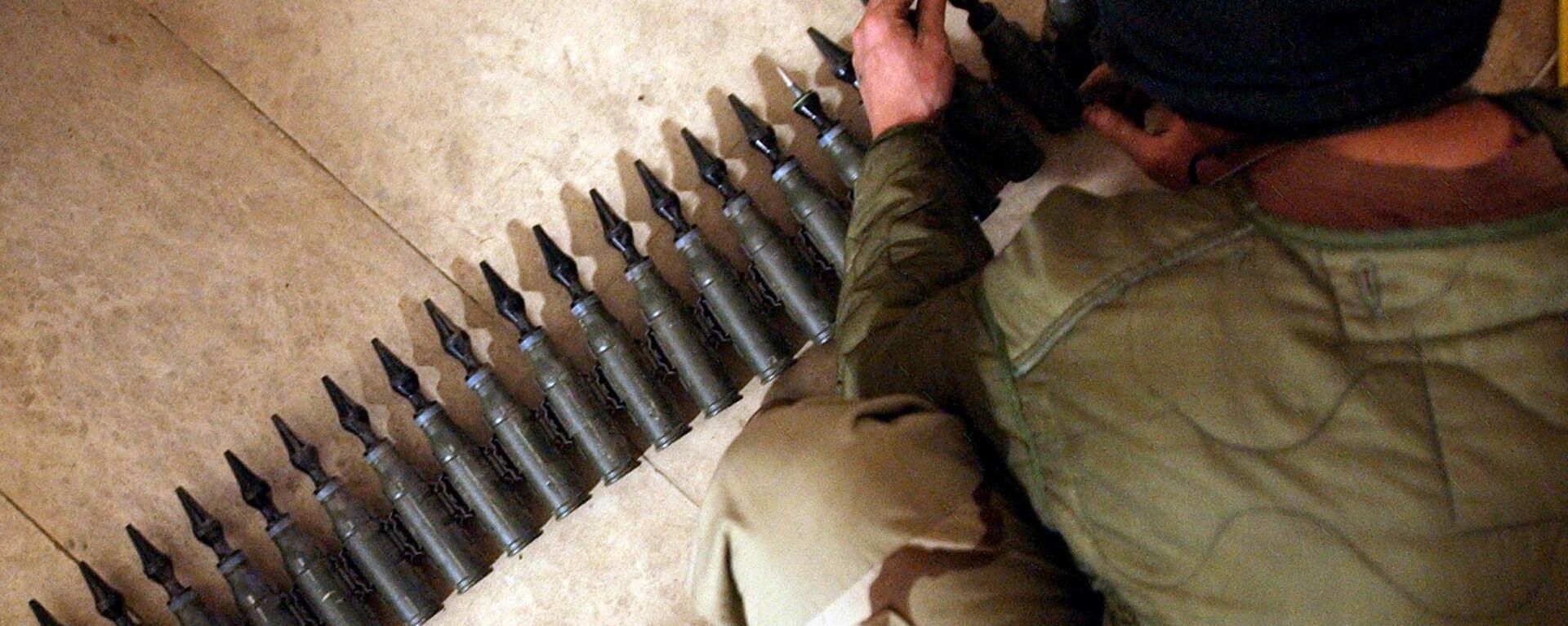
7 September 2023, 15:58 GMT
Why Do Pentagon and Defense Contractors Like DU So Much?
Lopez explained that from a military standpoint, the most important property of DU is its great density, relatively low cost of fabrication, and availability. The material is used for tank armor and projectiles of different sizes.
Highly-dense DU munitions easily pierce tanks and other armored vehicles. While tungsten carbide projectiles are capable of doing the same, DU is cheaper, more accessible, and offers greater margins for US military firms.
On the other hand, turning spent uranium into bullets and shells has become an "ingenious" solution for the US nuclear industry on how to "dispose" of radioactive waste, Lopez said in his book. So, as money talks, the US' testing and use of DU weapons continue unabated, according to the activist.
But has the Pentagon ever been aware of the long-lasting hazard related to DU projectiles?
The US Department of Defense's internal memos, leaked to the press in the late 1990s and the beginning of the 2000s, indicate that the Pentagon knew. But why would it use the toxic and radioactive substance nevertheless?
A March 1, 1991 document shows the US DoD's attitude to DU weapons use in a nutshell. Authored by US Lieutenant Colonel M.V. Ziehmn at the Los Alamos Laboratories in New Mexico, the memo reads: "There has been and continues to be a concern regarding the impact of DU [sic] on the environment. Therefore, if no one makes a case for the effectiveness of DU on the battlefield, DU rounds may become politically unacceptable and thus, be deleted from the arsenal."
The memo went on by saying: "If DU penetrators proved their worth during our recent combat activities, then we should assure their future existence (until something better is developed)," adding "we should keep this sensitive issue at mind when after action reports [sic] are written"; otherwise the US may lose "a valuable combat capability."
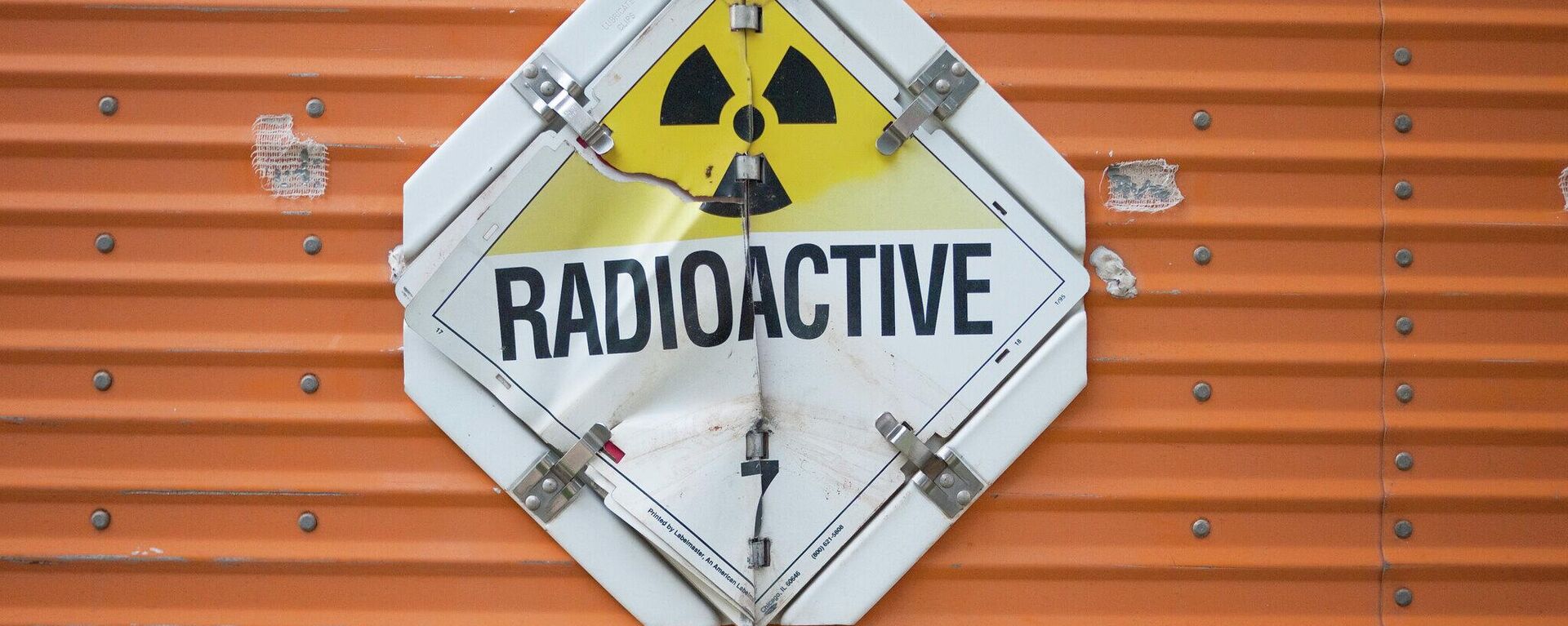
10 November 2023, 16:14 GMT
Why Are Pentagon and White House Keeping DU's Deadly Effects Secret?
The documentary Uranium 238: The Pentagon´s Dirty Pool (2009), used by Lopez's International Coalition to Ban Uranium Weapons (ICBUW) as part of its international campaign to prohibit DU, said that the Pentagon is in denial about DU munitions potentially leading to carcinogenic diseases, birth defects, and environmental contamination.
The US Defense Department has even invented a sort of "DU diplomacy" to reassure the world community and American citizens that there is nothing to worry about, according to the ICBUW. Meanwhile, the US has not only failed to inform affected nations – Iraq, Bosnia, Serbia, Syria – about the DU hazard, but also repeatedly exposed American soldiers to the toxic and radioactive waste. Per the documentary, DU weapons in all but name are a "dirty bomb" – a mix of explosives and radioactive material – used by terrorists. Yet somehow DU rounds are still called "conventional weapons."
One could easily imagine that if the US government admits
DU's hazardous effects, the weapon would be banned, influential defense contractors would be stripped of their profits, and Washington would be slapped with a heap of legal cases with compensation demands.
And the US is not the only country that uses depleted uranium as a weapon, as some of its NATO allies also do, according to Lopez.
"[The US keeps DU's deadly effect secret], for the same reason all the other countries that have the weapon kept secret, as much as they can keep it secret, it is because they know they're violating international laws, international conventions on weapons, and they know that they're going to have to pay the price someday, and they may end up with charges of violations of international laws. And so they're trying to protect themselves. And at the same time, they want to continue to keep the weapon because they're afraid other countries have weapons too," Lopez concluded.
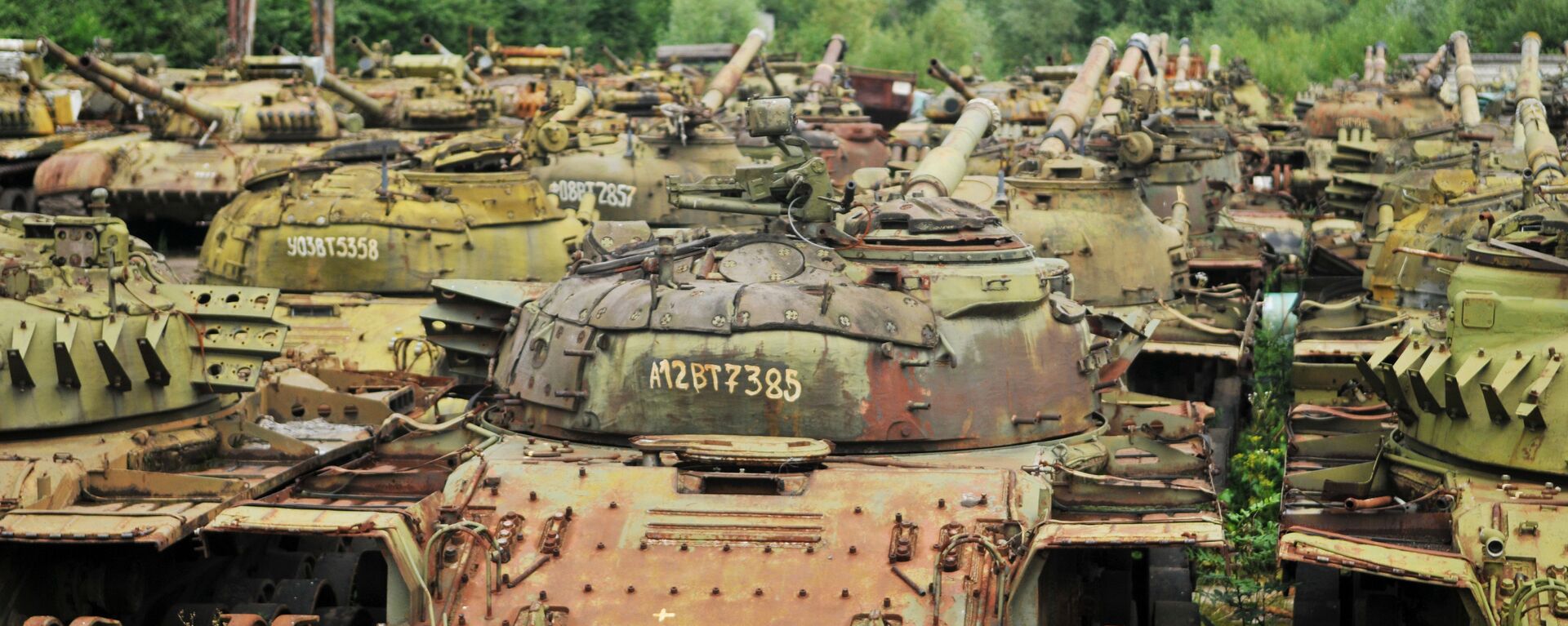
11 December 2023, 14:01 GMT
